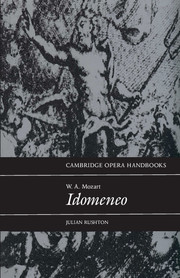Book contents
- Frontmatter
- Contents
- List of illustrations
- General preface
- Acknowledgements
- Introdution
- 1 Synopsis
- 2 Genesis of an operone
- 3 ‘Madame Dorothea Wendling is arcicontentissima’: the performers of Idomeneo
- 4 The genre of Idomeneo
- 5 From myth to libretto
- 6 Idomeneo after Mozart
- 7 General structure of Idomeneo
- 8 Two soliloquies
- 9 The musical language of Idomeneo
- 10 Tonality and motive
- 11 Elettra's first aria and the storm scene
- 12 Conclusions
- Notes
- Select bibliography
- Index
- Plate section
10 - Tonality and motive
Published online by Cambridge University Press: 05 June 2012
- Frontmatter
- Contents
- List of illustrations
- General preface
- Acknowledgements
- Introdution
- 1 Synopsis
- 2 Genesis of an operone
- 3 ‘Madame Dorothea Wendling is arcicontentissima’: the performers of Idomeneo
- 4 The genre of Idomeneo
- 5 From myth to libretto
- 6 Idomeneo after Mozart
- 7 General structure of Idomeneo
- 8 Two soliloquies
- 9 The musical language of Idomeneo
- 10 Tonality and motive
- 11 Elettra's first aria and the storm scene
- 12 Conclusions
- Notes
- Select bibliography
- Index
- Plate section
Summary
Key-schemes in Idomeneo
Helmut Federhofer distinguishes two possible approaches to large-scale tonal organisation in number operas such as Idomeneo: ‘Does the choice of tonalities only follow a musical-architectonic principle, as in cyclic instrumental forms, or does it, also or exclusively, serve a dramatic purpose?’ This is not the place to question the assumption that the choice of tonalities in cyclic instrumental forms does, in fact, follow such a principle. This choice, however, is intrinsically less likely to signify in opera, where the time-span is greater, the number of keys used for self-contained musical sections is far wider, and where poetic, visual, and dramatic considerations will be uppermost in the spectators’ minds, as they surely were in the authors’.
Nevertheless, Idomeneo, like other Mozart operas, has been analysed in terms of tonal schemes, approached from both points of view: the architectonic and the dramatic. In practice, the two are interlinked.2 Large-scale tonal schemes depend on the keys of whole numbers. In performance these are only tenuously, if at all, related to each other, since they are generally separated by recitative (or, in operas like Die Zauberflote, speech). A simple juxtaposition of related keys (as between Nos. 13 and 14, from G to C) appears semantically insignificant through its very ordinariness, as would related keys connected by short and simple recitatives. Where the recitative is longer and wider-ranging tonally (as is frequently the case in Idomeneo) the numbers are decisively separated, and apparently striking key-relations cannot be heard: hence in performance, key-relations between successive but separated numbers are hardly ever rhetorically effective.
- Type
- Chapter
- Information
- W. A. Mozart: Idomeneo , pp. 129 - 136Publisher: Cambridge University PressPrint publication year: 1993



